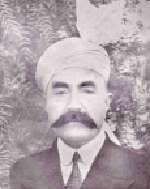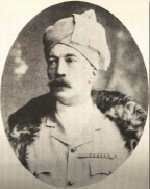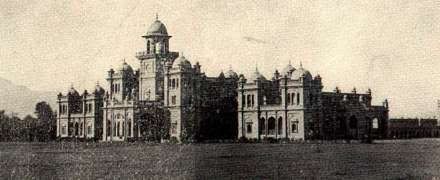
 In an earlier post I had described the different Pugrees worn across Pakistan, including the famed and flamboyant Peshawari Patkaiy or Kullah. There is an interesting story passed down by generations of students of Islamia College Peshwar about how this particular turban, once part of the prescribed college uniform, was abandoned by the College.
In an earlier post I had described the different Pugrees worn across Pakistan, including the famed and flamboyant Peshawari Patkaiy or Kullah. There is an interesting story passed down by generations of students of Islamia College Peshwar about how this particular turban, once part of the prescribed college uniform, was abandoned by the College.
As a background information I should add here that Islamia College Peshawar (ICP) was founded in 1913 by Sir Sahibzadah Abdul Qayyum, a Pushtun, and Sir George Roos-Keppel, the then British Chief Commissioner of NWFP, who was a virtual Pushtun in that he spoke Pushto fluently and also understood and adopted many of Pushtun customs.
While founding the ICP the two gentlemen tried to model their institution after the Aligarh Muslim College, which was founded 35 years earlier by Sir Syed Ahmed Khan. Following Aligarh’a example they also chose black achkan as part of the uniform for ICP students. To the achkan they added the local turban as head-wear. Both gentlemen, I should add, we proud turban-wearers themselves.
Thus the Peshawar Kullah along with black achkan, white shalwar, and black chaplis/shoes became the uniform of ICP students. However, the turban didn’t last long and was soon discarded. One reason for giving it up was that it didn’t sit too well on mostly 16-17 year olds who were usually too skinny at that age to sport this bulky head-wear. The other reason was more interesting and requires a bit of explanation.
In all the college hostels (there were 7) a bell would ring early in the morning and the students would stream out of their rooms into the hostel’s courtyard and line up, all dressed up in black achkan, white shalwar, black shoes and, of course, the Patkaiy or turban. First there would be a roll call to ensure that everyone was present, followed by an inspection. The hostel superintendent would pass by each student to see if he was properly dressed, which meant a properly buttoned up achkan, its collar hooked, no azarband hanging loose, the shoes shined and the shamla of the turban flared and proudly standing up.
Ditching the “dress parade” (that is what it was called) or turning up improperly dressed at the parade was considered almost a felony and the culprit was fined. Since boys were and will always be boys, they couldn’t resist pulling pranks on each other. When everyone was rushing out of his room to join the dress parade, one tug at the tail of someone’s turban would unravel the turban and the student would end up missing the parade.
And this happened not too infrequently. As an insurance against such mishaps the students would keep an extra turban ready to wear. If one were pulled apart at the last minute, the ‘victim’ would quickly fetch the other, don it and rush back to join the parade.
But there was not always a happy ending to such episodes. So, legend has it, the college administration mercifully decided to abandon the turban altogether – to the relief of the latter generations including mine.
Mast Qalandar is a proud alumnus of Islamia College Peshawar.Originally published at ATP on December 20, 2006.






















































Interesting discussion. In support of their argument a few of my pathan friends have also indicated to a culture of lending money on interest in the rural areas. They say the lender almost never likes to be paid the actual principal amount. This along with what discovery channel and bbc documentaries have shown is just facinating to me.
Ahsan,
That’s a whole new perspective. I didn’t look at it from that angle. I am glad, though, I didn’t have to wear the turban. I would rather learn to do binomial theorem than learning to tie the turban.
Saadia,
This is a whole new discussion, and a very interesting one, too. Perhaps, we can have a post on it in the future if we can sufficiently link it to Pakistaniat. Talking of Musa, it seems to be everywhere in NWFP. There is a well known mountain peak, 13-14,000 feet high, beyond Kaghan valley. It is named Musa ka musalla or the place of Moses. So, there must be something to it. (Incidentally, Adil, our ATP editor, mentioned somewhere on this blog that his son is also named Musa.)
[quote post=”461″]One reason for giving it up was that it didn’t sit too well on mostly 16-17 year olds who were usually too skinny at that age to sport this bulky head-wear. [/quote]
Dear MQ,
In the above quote, in my opinion, the “skinny” does not seem to be a convincing reason. I think the reason is more aesthetic. At this age some of the boys are so handsome (beautiful!) that this impressive kulla simply does not sit right on their heads!
Yes you are right about names. I know it from my family, I tell you funny part about our family tree. Actually after several names, it was broken at one point and my late father drew a long line and at end wrote the name Prophet Musa/Moses.
Magen/star of David symbol has 6 corners and the shape on left side (where ICP photo is on Red note of 100 Rupee) has also 6 corners. You know Jews drew the star of David in different ways but leave the 6 corners symbolic.Anyway we have each shape in each Pakistani rupee note so it can be only coincident and my theory is only a silly one.
Saadia,
I don’t remember the star on the 100 Rupee note but am aware of the theory that Pathans (and Kashmiris) are some of the lost tribes of Israel. Only recently I watched a documentary on the History channel supporting this theory. I found it fascinating — and plausible.
One thing that strikes me in the region is the names of the people. You find far too many names from the Old Testament in this area than any Muslim population elsewhere. For example, Musa (Moses), Ishaq (Issac), Yakub (Jacob), Ayub (Job), Daud (David) and even Israel are common names. Then there are certain customs and other similarities. Anyway, it is whole a new subject.